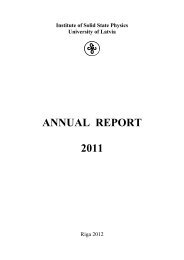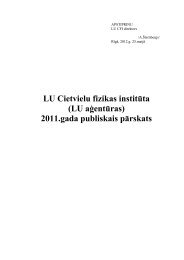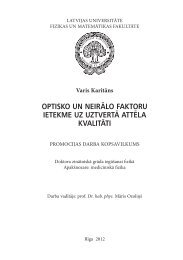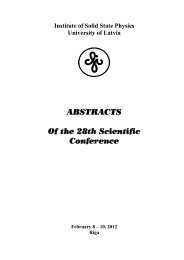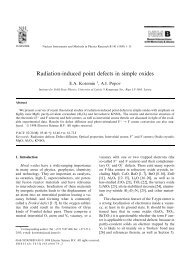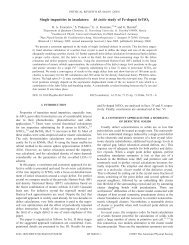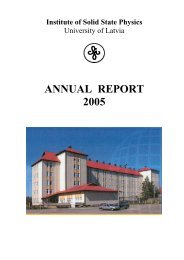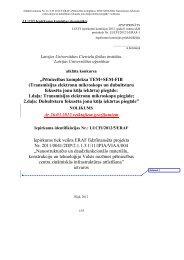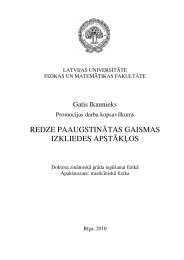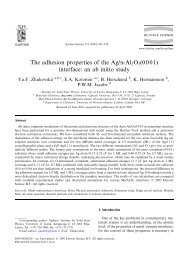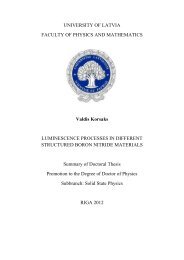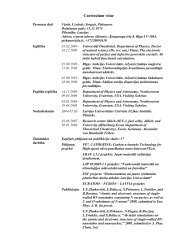Annual Report 2012 - Latvijas Universitātes Cietvielu fizikas institūts
Annual Report 2012 - Latvijas Universitātes Cietvielu fizikas institūts
Annual Report 2012 - Latvijas Universitātes Cietvielu fizikas institūts
You also want an ePaper? Increase the reach of your titles
YUMPU automatically turns print PDFs into web optimized ePapers that Google loves.
CONTROLLED MANIPULATION AND MECHANICAL<br />
CHARACTERIZATION OF NANOWIRES<br />
B. Polyakov, P. Kulis, S. Vlassov, L. Dorogin, I. Kink, R. Lohmus<br />
One-dimensional solids such as nanowires (NWs) and nanotubes (NTs) exhibit<br />
many unique optical, electrical, mechanical, and other properties that make them<br />
candidates for numerous future nanoscale devices.<br />
In many applications NWs are subjected to<br />
mechanical stresses and deformations. In flexible<br />
electrodes, as well as various<br />
nanoelectromechanical systems (NEMS) like, e.g.,<br />
nanorelays, nanoswithces and nanoresonators,<br />
NWs are required to withstand numerous repetitive<br />
deformations. The investigation of NWs<br />
mechanical characteristics is of a great importance<br />
for performance of the named systems.<br />
The manipulation of NWs or NTs is<br />
frequently employed to position and assemble<br />
prototype nanodevices. Depending on the<br />
magnitude of its static friction and its ultimate<br />
strength, a NW may be displaced or broken as a result of manipulation. Static friction of<br />
NW on flat substrates is strong enough to maintain even highly deformed NWs in a bent<br />
state, which produces high strain and is especially important for piezoelectric materials<br />
such as zinc oxide.<br />
Young’s modulus, bending strength or yield strength of copper oxide (CuO), zinc<br />
oxide (ZnO) and silver (Ag) NWs were measured in situ using nanomanipulation<br />
techniques inside a scanning electron microscope<br />
(SEM). Young’s modulus was measured by<br />
bending half-suspended NWs and simultaneously<br />
measuring the force using a sensor based on a<br />
Gradual bending and fracture of a ZnO NW during controlled<br />
loading by AFM tip inside SEM (a-f). Calculated the “most<br />
bent state” laid over the SEM image was used to estimate<br />
static friction and strength of NW (e).<br />
quartz tuning fork. Bending strength was measured for the NWs on a flat surface by<br />
bending them from one end with an AFM tip until the NW breaks or plastically deforms.<br />
The profile of the elastically deformed NW and the average value of Young’s modulus<br />
were used to calculate the bending strength or yield strength of the NWs.<br />
Scientific Articles<br />
1. P. Kulis, J. Butikova, B. Polyakov, G. Marcins, J. Pervenecka, K. Pudzs, I. Tale.<br />
Work function of colloidal semiconducting nanocrystals measured by Kelvin probe, IOP<br />
Conf. Ser.: Materials Science and Engineering, 38, 012048, <strong>2012</strong>.<br />
2. J. Butikova, G. Marcins, B. Polyakov, A. Muhins, A. Voitkans, I. Tale. Processing<br />
of amorphous Si by pulsed laser irradiation at different wavelengths, IOP Conf. Ser.:<br />
Materials Science and Engineering, 38, 012009, <strong>2012</strong>.<br />
3. B. Polyakov, L. Dorogin, S. Vlassov, M. Antsov, P. Kulis, I. Kink, R. Lohmus. In<br />
situ measurements of ultimate bending strength of CuO and ZnO nanowires, European<br />
Physical Journal B, 85, 366, <strong>2012</strong>.<br />
4. B. Polyakov, S. Vlassov, L. Dorogin, P. Kulis, I. Kink, R. Lohmus. The effect of<br />
substrate roughness on the static friction of CuO nanowires, Surface Science. 606, 1393-<br />
1399, <strong>2012</strong>.<br />
25



